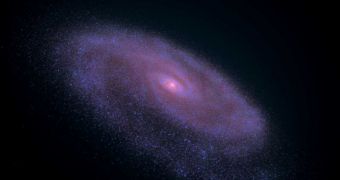Recent simulations performed by astrophysicists demonstrate that in galaxies such as Milky Way, stars like our sun travel far from their place of origin.
Back in 1633, Galileo Galilei came up with a theory that placed Earth in the orbit of the sun and that led to the Church and public opinion, under fire, threatening the scientist with torture, as described in an article earlier today. That's not the point now, though, but rather the fact that people hadn't even thought of that before, since it was common knowledge that Earth was the center of the universe. Similarly, I guess we have to admit that most of us never thought of whether our own sun is originally from here or it came to this place from somewhere else. Well, not all of us.
Some scientists from the US, UK and Canada have recently performed a simulation that contradicts the common belief that stars evolve and die pretty much in the same area where they were born. They used data collected in 100.000 hours (11.5 years) of computer simulations, divided between a computer cluster at the University of Washington and a super-computer at the University of Texas. The simulation targeted the birth and evolution of a galaxy disk from 4 billion-years of post-Big Bang swirling material.
The software, which was based on specific physical properties, data, and parameters, began the simulation with a computerized re-creation of the conditions 9 billion years ago, when the material for our galaxy's disk had accumulated but the actual process of its formation hadn't started yet. The basic parameters were inserted in order to mimic the galaxy formation, but the galaxy that emerged was then left to develop and evolve on its own.
Rok Roškar, a doctoral student in astronomy at the University of Washington, gives some insight: "Our view of the extent of the habitable zone is based in part on the idea that certain chemical elements necessary for life are available in some parts of a galaxy's disk but not others. If stars migrate, then that zone can't be a stationary place." He further explained that this idea could change the scientific view on the place and the manner life appears and evolves in a galaxy.
The simulation showed that, when a star is intercepted on its circular trajectory around the galactic core by a spiral arm, its moves don't become erratic, as previously believed, but instead they remain circular, although its orbit becomes smaller or greater. This may also apply to our circular-orbit sun, meaning that 4.59 billion years ago (50 million years before Earth) it may have been born closer to or farther from the galaxy's center than where it is now. The migrating stars theory also addresses the problem of the chemical composition of the sun's neighboring stars, thought to be more diluted and mixed than in the case where stars stayed where they had formed.
"Our simulated galaxy is very idealized in the formation of the disk, but we believe it is indicative of the formation of a Milky Way-type of galaxy," said Roškar. "In a way, studying the Milky Way is the hardest thing to do because we're inside it and we can't see it all. We can't say for sure that the sun had this type of migration." James Wadsley, a team member from McMaster University in Canada gives further explanation: "When you swirl cream into a cup of coffee, it will rarely look exactly the same twice, but the general process, and the resulting taste, is always the same."
Although the results are based on a small number of simulations, further runs of the test are expected to provide similar data. The team intends to vary the physical properties in their future simulations in order to obtain different galactic disks and determine whether the stars display the same migration ability for those as well.

 14 DAY TRIAL //
14 DAY TRIAL //